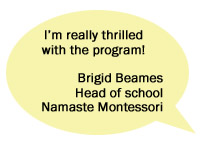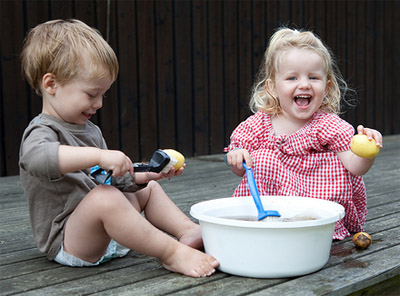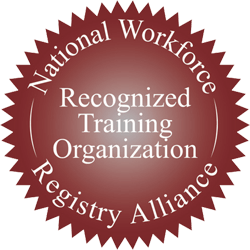|
…the task of the educator lies in seeing that the child does not confound good with immobility, and evil with activity, as often happens in the case of the old-time discipline. And all this because our aim is to discipline for activity, for work, for good; not for immobility, not for passivity, not for obedience. A room in which all the children move about usefully, intelligently, and voluntarily, without committing any rough or rude act, would seem to me a classroom very well disciplined indeed. ”
|
| (A Montessori quick bite from The Center for Guided Montessori Studies) |
|
Is there such a thing as too much freedom? Once when I was in Nepal I saw a two year old sweeping his fathers’ shop with such a look of intense concentration that I could not doubt the seriousness of his effort. Children have always played a role in the work of the family. It is a new notion, this fantasy of childhood as an idyllic refuge from the ugly world of adults; it speaks more to how we see our own lives than to how children see their own. From most ancient times, from the first flickerings of civilization, the great task of children has always been to become adults. All day they would spend with their family, their tribe, their kin, working to the extent they could and contributing meaningfully to their own survival. We should not idealize the harsh reality of subsistence living; but we do a terrible disservice to ourselves if we denigrate the value of work. If the games of children are found to be filled with fantasy constructions, this is because the last remaining place for these seems to be in childhood. Adults, too, once believed in elves, fairies, giants and witches. These were real entities in the world, unseen powers that were believed to affect our lives. Now, the last redoubt for this part of our heritage lies in the play activities and fantasies of childhood. This is fine, but just as children may pretend to possess magic powers, they also like to pretend to have adult jobs, such as doctors or astronauts or teachers. The essential role of fantasy is to help children explore and prepare for adulthood through the tool of their imagination. Because we often misunderstand the nature of childhood, we also often misunderstand our own children. We do them no favors, protecting them from responsibility. When a child acts out, it is often because no meaningful contribution is made available to them. Think of parents rushing around preparing for dinner guests. The dishes must be cooked, the table set, the house cleaned. Why is it that in this flurry of activity children are often underfoot, getting in the way? Frustrated parents may tell a child to “go play”, or resort to punitive discipline. A thoughtful observer may note a shadow of disappointment across a child so banished from family activities. It is a simple formulation: if there are important things happening, and I may not contribute, then what does this say of what I am and who I may become? It is not surprising then that children with too much of what we call “freedom” become locked into a state of permanent emotional childhood. There are many persons, physically adult, who spend their days in non-productive activity, such as playing video games in their parents’ basements. Even adults don’t cherish freedom without responsibility, though they may imagine they would.1 Workplace studies have compared different task sets, and have found that even with the same pay, persons report much greater job satisfaction when they have greater responsibilities. Dr. Montessori designed her classrooms with this insight into human nature. Children are free to choose any work they have been taught, but they must complete it and then get it ready for the next child, including putting it away neatly. Children may have snack when they are hungry, but they must prepare it themselves and clean up any messes they make. Many a Montessori classroom has a posted sheet of classroom chores and it’s a marvel to see children treat these chores as if they were privileges. As children age we imagine them to be ready for more responsibility. In most US states, one cannot work before 14, drive before 16, vote before 18 and drink alcohol until you are 21. Oddly, we do little to prepare them for these responsibilities. We teach them to drive, yet 400,000 teenage drivers are seriously injured every year.2 We give them the vote, but cut civics education from our curricula. Regarding alcohol, one day they cannot drink legally, the next they can; should we be surprised by the epidemic of binge drinking and alcohol poisoning? It is our job as Montessori educators to provide children with the necessary frameworks to succeed in ever-larger spheres. As Montessori children age, they assume ever greater independence and responsibilities. By kindergarten or early Elementary they are planning out their activities for a week. They are taught research skills and by the middle Elementary years they are conducting months-long independent research. By upper Elementary or Middle School Montessori children are often running small businesses. Is it any wonder that so many entrepreneurs credit their Montessori foundations with their success?3 The Montessori Method is not simply a pedagogical technique for communicating facts. It is a proven system for helping children develop independence and assume greater responsibilities. This is one reason why Montessori children are often perceived as more “mature” than traditionally educated children. In our classrooms, yes, a child is free. They are free to move about, with purpose. They are free to use the works they please, so long as they use them appropriately. An essential part of a healthy freedom is responsibility, and our classrooms satisfy this need.
Footnotes
Thoughts for the day:
|
Blog
Our thoughts on Montessori and education
Some Montessori Myths
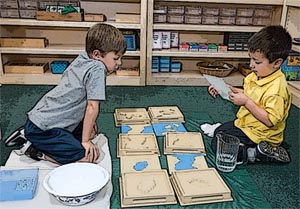
|
| (A Montessori quick bite from The Center for Guided Montessori Studies) |
| There are so many myths about Montessori. On a trip to Vietnam I once encountered a public school principal concerned that Montessori wouldn’t work there because, she said, “Montessori is all about the individual, and here we believe in cooperation.” I have heard the opposite, too, of course. A father from Texas told me with perfect seriousness that the big flaw with Montessori was that “the kids don’t have to learn anything, they can just ask another kid for the answer.” Besides, he told me frankly, he didn’t want his son at a school where “they just sit and talk all day.” In contrast, a few months ago I met a mother who happened to visit a normalized classroom at a period of intense concentration. She decided that she didn’t want her child in such an “eerily quiet” environment.
Every child is a natural Renaissance master, exploring all of creation without the boundaries of disciplines. They leap from interest to interest with a passionate inquisitiveness. As Montessorians, we nurture their inquiries into the beauty of our world’s mysteries. This makes them more, rather than less prepared to navigate the messy complexities of the real world. We are often reminded that Dr. Montessori developed her method by observing children’s natural behavior; it should be no surprise that it helps the child harmonize so well with the real world. At CGMS we work with schools from many nations, each with its own culture and conditions. Dr. Montessori’s science of childhood revealed a universal approach that works equally well for children in the slums of Rome, an African village, a New Jersey suburb, or the capital of France. There are wonderful Montessori schools on every settled continent, and like the countries they inhabit, each classroom has its own culture. If there is anything that ties these superior schools together it is this – they respect and understand the needs of their children. In a Montessori classroom, children will learn to cooperate. They will also learn to work alone. They will socialize. They will focus on their individual work in utter silence. They will do these things because they are human beings, and because the prepared environment gives them the opportunity to act as such. Contrast this with a teacher-centered pedagogy. When children collaborate in Elementary, Middle or High School it is called “cheating”. But in the modern workplace a key predictor of achievement is being able to work well in teams. This is recognized by academics, for example, two researchers from the University of Minnesota said that “learning to work together in a group may be one of the most important interpersonal skills a person can develop” . The importance of collaboration is also recognized by the public at large, as in a 2003 study by the University of Connecticut which concluded that most workers agreed that “being a ‘team player’ is of paramount importance in the workplace”. Montessori schools allow children to develop these essential collaborative skills from the earliest ages. By denying the essential nature of children, traditional schools do a poorer job preparing children for success in the real world. Perhaps at times the world is noisier and less ordered than a Montessori classroom. What of it? Mainstream theories of pedagogy assume that the teacher’s job is to shape the student. But children are not delicate constructions assembled by teachers. Children are consummate engineers. Remarkably, even in impoverished environments, in time most children manage to assemble themselves into functional adults. With the enriched environment provided by Montessori, what might they become? It should be no wonder that a strong foundation may help children develop into remarkable adults. So, do Montessori schools teach enough? Do they teach too little? Do they, as feared by the French gentleman at the beginning of this missive, ill prepare children for the messiness of the real world? These questions all misconstrue what the Montessori method does. It does not “teach”, in so far as teaching is thought of as filling empty heads with knowledge. Instead, it allows children to acquire knowledge in a natural way, while nurturing those critical skills necessary for both individual concentration and team collaboration. Further reading: If you are interested in the importance of team work in the modern workplace and in research done on educational techniques for developing these skills, we highly recommend exploring www.co-operation.org, the website of Dr. David W. Johnson and his brother Dr. Roger T. Johnson. They offer newsletters, classes, books and plenty of free reading on this essential and fascinating topic. |
Mistakes and Freedom
|
|
| (A Montessori quick bite from The Center for Guided Montessori Studies) |
|
Adults enjoy more freedoms than children. We can eat ice cream when we want. We can stay up as late as we wish. We can watch TV until our eyes fall out. We may choose to quit an unsatisfying job, or to move to a better house. We may choose to do more of the things that we enjoy, some of which may not be good for us. The freedom to do what we want carries with it the burden of making good choices. How do we prepare children for this freedom? Let’s consider this example. The girl will tell you she’s four and a half, and that’s a very important distinction to her. Her brow is creased in concentration as she leans over a rug on the floor. Spread out below her are eight cards, four pairs of opposites which she is trying to organize and label. She’s having trouble. She sounds out the labels again – Up, Down, Big, Little, Dark, Light, Hot, Cold. She knows these words. But something isn’t right. At home, she’s learned to expect her helicoptering father every time she hits some difficulty. Her challenges are his anxiety – he worries that she’ll become too frustrated and turned off from harder tasks. Just yesterday she was doing a puzzle and he pointed out where a missing piece went. “I can do it, Daddy!” she tells him time and again. But he distrusts the look of concentration on her face, and finds it very difficult not to offer unsolicited hints. She is not quitting. “Up” and “Down” were easy peasy. There’s a picture of a funny little man running up or down the stairs on each card, she can tell which way he is going because of the way he faces. The picture of the ice cube, she knows that has to be “cold.” And the opposite of that has to be the “hot” grill. She knows grills are hot, she’s been told that many times when her parents are cooking out back. She must have cold and hot right. She turns the cards over, and sure enough they have the same color dot on the back. But something is wrong with the other opposite cards. She doesn’t know it, but in a traditional classroom there probably wouldn’t have been that dot on the back of the card. Such a little thing. Such a world of difference. In a traditional “preschool” or daycare setting the girl would be expected to raise her hand and wait for an adult – hopefully wise, hopefully friendly, but always busy – to find the time to come over and give her a hand. How can a child learn unless she is taught? Both the lighthouse and the boat are big, but the lighthouse is bigger. Both pictures had sand, but look, there’s a picture of a toy boat too. It makes more sense for the boats to be “big” and “little”. Her eyes widen and she relaxes. She sees her mistake; the picture for “dark” must be the lighthouse at night. She wasn’t sure because it was a silhouette, and there’s more water in that picture. But if she does it this way then the boats can go together and the lighthouses can go together. She arranges the cards and puts their labels underneath. She’s almost sure she has it right now. It all makes sense. She flips all the cards and sees that, yes, the color coding all matches. Satisfied, she completes the work. She randomizes the cards to make the work fun for the next child, and returns it to its shelf. Children are people, and people make mistakes. Unlike mainstream pedagogy, in Montessori we cherish children’s freedom to make – and correct – their own mistakes. We call this process “control of error”, and it is built into every Montessori work. When a Montessori teacher introduces a child to a new activity, the lesson includes the tools the child needs to perform a self evaluation. But why is this so important? This is the question we ask today. Dr. Montessori discovered a secret. This is the secret that the authoritarians of the world desperately hope will never become common knowledge. The secret is that we are all ready for freedom. We always have been. We are not individuals without it. To rob a person’s freedom is to reduce their humanity, to treat them as puppets. If we cherish our society’s freedoms, we must respect the individual. Dr. Montessori realized that respecting the child meant acknowledging their person-hood. For this reason she designed classrooms that afford children freedom of choice and freedom of movement. How can you be free without the ability to make meaningful choices? How can a school help prepare children for the freedom of adulthood without granting them the experience of freedom? Of course freedom also means the capacity to act in error. Authoritarians shudder, imagining that left to their own devices children will do nothing productive and cause no end of trouble. Of course, this is not what we see. Dr. Montessori said that the work of children was to create the people they will become, and we find that they pursue this task with marvelous diligence. But children do make mistakes – errors in movement, academic errors, and errors in judgment. It is the goal of the Montessori method to assist children to recognize and to resolve their errors on their own. For children are not malfunctioning machines for us to “correct” – they are people and deserve the dignity of discovery and self-correction. Humans learn from their mistakes, so we must permit children to make them. The Montessori materials are designed at their core to incorporate this concept. Every work a child performs includes a tool for control of error. The idea is that a child’s engagement with the material should be sufficient for self-learning, rather than requiring the adult in the classroom to pass judgment. Not all of the learning in the Montessori classroom is academic. In the social environment, too, we celebrate freedom. Interpersonal conflict is a challenge for children and adults alike, and the Montessori classroom offers both the freedom for these conflicts to arise, and an environment uniquely well suited to solving problems harmoniously. Activities such as a peace table or grace and courtesy lessons are all designed to give children the tools they need to understand themselves, each other and to learn to resolve these conflicts when they arise. Outsiders often remark that Montessori children seem so mature “for their age”, and this may be one reason why. Science shows us that emotional intelligence (EQ) is a better predictor for success than any academic measure. The Montessori classroom is designed to give children a special environment in which to strengthen these emotional skills. Dr. Montessori’s secret is that freedom, independence and dignity are all interrelated. Aging adults often resent the loss of independence represented by moving into an assisted living facility. Both the aged and infirm say they hate “being treated like children.” Children hate being treated like children, too, because the way children are traditionally treated interferes with their need for freedom and independence. The safe prepared environment of the Montessori classroom affords children the freedom to correct their own errors, develop their individuality, and mature into the adults our society needs. Thoughts for the day:
CGMS has applied for accreditation of its online Elementary Full Certificate course with residential seminar locations in Indiana, Florida and New York from the Montessori Accreditation Council for Teacher Education (MACTE). Our Primary Full Certificate program with residencies in Sarasota, Florida and Kingston, NY, is already accredited by MACTE. We have also applied for accreditation of the additional early childhood location in Indianapolis.
To learn more about our teacher certification programs, please email us or visit our website at http://www.guidedstudies.com/montessori-certification-online.html.
|
Grades, Success and Tiger Mothers
 |
| David DeHetre, released under the Creative Commons License, some rights reserved |
“Once we have accepted and established our principles, the abolition of prizes and external forms of punishment will follow naturally. Man, disciplined through liberty, begins to desire the true and only prize which will never belittle or disappoint him,- the birth of human power and liberty within that inner life of his from which his activities must spring.”
- — Dr. Maria Montessori
My System of Education
(A Montessori quick bite from The Center for Guided Montessori Studies)
On January 8th, 2011 The Wall Street Journal published an upsetting article by author Amy Chua titled “Why Chinese Mothers Are Superior”. An excerpt from her new book, the article claims that the secret to academic success is tyrannical control over the child. Ms. Chua proudly explains that her two daughters were never allowed to have play dates, choose their own extracurricular activities, or receive any grade other than an A.
Furthermore, she explains what she calls her “Chinese” negative motivation technique – insulting her children by calling them “garbage” and threatening them with the loss of meals, presents, toys and birthday parties. Ms. Chua says, “the solution to substandard performance is always to excoriate, punish and shame the child.” In one particularly abusive example, she recounts denying her daughter the right to eat or use the bathroom for hours until she mastered a piano piece.
Ms. Chua calls this technique of parenting through physical and emotional domination the “Chinese mother” style. In recent television appearances she has defiantly shown an appalling lack of self awareness of the cruelty she has wrought on her children. She will, she says, leave it for “Western” mothers to raise the “losers”.
The invidious stereotypes of Ms. Chua’s article have caused some controversy to be sure. Like many others, I can say that her characterization of Asian families is certainly not backed up in my experience – and I’m married into one. I suspect that Ms. Chua has rationalized her abusive behavior by cloaking it in the generalization that she is, somehow, normal.
Ah, but only if she were that rare! There are many parents of all ethnicities who think any behavior should be excused in the name of raising grades. Children hate working, goes the thinking, therefore the only way to get them to excel is to subjugate their will to their wiser elders.
As Montessorians, we know that cultivating intrinsic motivation is the most effective way to increase the productivity of both children and adults. Ms. Chua was correct in that she could, for a time, force her children to do better in school by dominating and emotionally abusing them. But in her memoir, Ms. Chua herself recounts the dramatic rebellion of her younger daughter.
But perhaps the weakest element of Amy Chua’s reasoning is the assumption that grades will themselves lead to success in life. Even many of the arguments made against her accept the axiom that a high GPA promises wealth, prosperity and happiness. In fact, this is not the case. The tragedy is that she traumatized her daughters for nothing.
What is success? If measured by income, grades at best weakly correlate with success. Persons who get A’s and B’s generally earn a bit more over their lifetimes than those who received C’s and D’s in high school and college. On the other hand, many studies paint a very different picture. For example, a longitudinal study of valedictorians show that they are no more – and perhaps less – likely than their peers to be successful in any measureable way. This study was described by Sheila Tobias as “An important corrective to the notion that success in high school inevitably prefigures success in college, in life, or in careers.” Another study of success by Richard St. John also concluded that grading does not lead to success and identified 8 traits that were strongly correlated.
“ Learning is a result of listening, which in turn leads to even better listening and attentiveness to the other person. In other words, to learn from the child, we must have empathy, and empathy grows as we learn. ”
|
In other words, good grades mean something but not a lot. Richard Branson, Thomas Edison and Isaac Newton were all undistinguished students, and Winston Churchill failed the sixth grade. Both Charles Darwin and Carl Jung were called “stupid” by their teachers, and Louis Pasteur was near the bottom of his class in college. Leo Tolstoy flunked right out. Werner Von Braun failed algebra and Louisa May Alcott was told she would never succeed as a writer.
Academic success is at best an imperfect predictor of success if measured by either income or notoriety.
So, what is the best predictor of success? New York Times science writer Daniel Goleman makes a convincing argument for emotional intelligence (EI) – the ability to understand and cooperate well with other human beings. In a study of the outcomes of students who attended Harvard in the 1940s, Goleman found that those “with the highest test scores in college were not particularly successful compared to their lower-scoring peers in terms of salary, productivity or status in their field, nor did they have the greatest life satisfaction, nor the most happiness with friendships, family and romantic relationships."
On the other hand, Goleman identified a clear connection between emotional intelligence and every other measure of success that he measured. People with a high EI are the ones “who truly succeed in work as well as play, building flourishing careers and lasting, meaningful relationships.” Is it a coincidence that peaceful, cooperative work is at the heart of the Montessori method, rather than grades? Once again, modern science catches up with Dr. Montessori’s prescience.
Certainly doing well in school doesn’t necessitate the abandonment of individuality, nor does it follow that if you receive good marks in school that you must be an unoriginal thinker.
But three things are readily apparent:
- The traditional school system rewards rote memorization more than creativity, yet the workplace requires creativity more often than rote memorization.
- The traditional school system pits students against each other in class rankings and measures each child’s work in isolation, yet it is success in navigating the dynamics of group projects that plays a more essential role in the modern workplace.
- By pressuring a child to do better in school, a parent also pressures a child to become that thing which the school most rewards – a rote memorizer pitted against other rote memorizers.
Integral to the Montessori method is respect for the child. The child is neither a tabula rasa, nor a willful opponent, but a unique and marvelous creation. Dr. Montessori built her method on the bedrock of mutual understanding, cooperative projects and conflict resolution. We hold in our hearts the faith that a more peaceful and joyful world is found in the secrets of childhood Dr. Montessori studied a century ago.
Science now suggests that the very same method could unlock a more productive and wealthier world as well. In economically uncertain times, what are our leaders waiting for?
Thoughts for the day:
- If there is so much evidence that grades don’t matter, why are they still used for assessment?
- What role does assessment and progress reports play in a Montessori environment? How do you personally support children’s natural motivation to learn without imposing predetermined goals and standards?
- In Montessori we consider observation to be our main method of assessment. What systems have you put in place to help you perform this most important part of our job?
- How can you use authentic Montessori assessment strategies to support the needs and interests of your students, while respecting each individual’s creativity and unique learning style?
- How can you help your parents better understand the importance of intrinsic motivation? Will this help you to strengthen the partnership between school and home?

There is still time to enroll in our professional development courses. These include working with children with Special Needs, a Math Refresher, a Language Refresher, our Adventure in the Arts course, and our Classroom Leadership course, which is particularly useful to classroom assistants.
Our next Primary and Elementary teacher cohort groups begin soon. If you are interested in becoming a certified Montessori teacher, now is the time to enroll! In both our online-only Associate Certificate, and our low-residency Full Certificate program, you will get the same thorough and well-respected training from some of the world’s leading Montessori educators. The CGMS training program has been carefully designed to combine the best practices of over a century of Montessori training with the most up-to-date e-learning techniques. The result is an authentic program unlike any other.
To learn more about our teacher certification programs, please email us or visit our website at http://www.guidedstudies.com/montessori-certification-online.html.
“Where the children work for themselves…”
“From such a system there comes forth a school where the children work for themselves – that is, they are free. In this freedom they work much more than heretofore has been customary in school…
and they attain culture more rapidly and more efficaciously… This educational problem, which today science propounds, is solved, though it was considered among the insoluble questions such as the fourth dimension, perpetual motion, and the squaring of the circle. The problem is to lessen effort and at the same time increase output.”
|
||||||||||||||||
| (A Montessori quick bite from The Center for Guided Montessori Studies) | ||||||||||||||||
|
A century ago, Dr. Montessori discovered that freedom and excellence are intertwined. Both children and adults today could benefit from applying this insight to our schools and work places. Our traditional school systems are built like our traditional factories. Even the end-of-period bell mimics the shift-break bell in an industrial facility. Having once worked in a traditional factory myself, I can attest that the similarity of cultures continues to this day, authoritarian and unstimulating environments where questioning and collaboration are both disdained. In fact, the traditional school system was designed in tandem with the support of early "efficiency experts" with the goal of producing ready workers for industrial expansion. It’s curious that today we still find these alienating attitudes in our workplaces and schools. Not just our educators, but our business leaders also should know better. In the 1980s, businesses around the world began to take note of unusually efficient processes at automotive factories in Germany and Japan. These factories produced more cars at lower cost and with fewer errors, yet oddly they upended a great deal of standard practice. Consultants discovered that these workers collaborated more, especially with management. However, there was one extremely startling difference at the most successful of these factories. In traditional factories, such as the one I worked at, workers’ responsibilities are quite constrained. For example, my job was to put rubber gaskets on circuit boards. I couldn’t go too fast or too slow lest I risk disrupting the production queue. Because of union rules and shop practice, I was not to inspect the parts for any problems, so I needed to ignore even the most glaring defects which would render the final devices useless. My job, like many others, was essentially to "pull a lever." It was certainly dispiriting, but it also struck me at the time as rather inefficient. In contrast to the one I worked at, consultants found that at the most effective factories, worker responsibilities were extended beyond the rapid production of the next part to encompass the overall quality of the product. Workers who spotted any defect were allowed to call a halt to production if necessary. These workers weren’t just pulling levers, they knew the purpose of their work and felt ownership and pride over the output of the factory. Work should be ennobling, but far too frequently it is not. Way back in 1968, a management consultant by the name of Fredrick Herzberg studied workplace efficiency and concluded that the intrinsic motivators of work (the pleasures of the job itself) outweighed the motivation of extrinsic factors such as pay, vacation or even the perks of the work environment. Obviously people need to be fairly compensated for their work in order to feel motivated, but beyond that point extra dollars did not lead to extra effort. Things that did included providing employees with the freedom to accomplish tasks in the ways best suited them, and extending their responsibilities "vertically" to encompass more of the work process. The more responsibility offered an employee, the greater their own reported sense of satisfaction. This contrasted against the negative effects of "horizontal" job loading an employee, for example by challenging them to tighten twice as many bolts in a day. In Montessori, too, we talk about intrinsic motivation as superior to extrinsic motivators such as grades or even praise. In fact, Herzberg’s studies of adults show that intrinsic motivators produce superior results, one more way the Montessori method better prepares children for the real world. It is interesting today that despite the fact that we know we both learn and work best when we are interested, schools and workplaces are still constructed around the premise that students and workers are adversaries of teachers and employers respectively. If we treat children and adults as if they can’t be trusted to want to do their work, is it surprising that they don’t act like they want to be at their schools and offices? Is it surprising that our schools are failing, or that workplace productivity is lagging? These are direct cultural and economic consequences that follow from the way people are treated. If we assume students do not wish to learn, then we get bored students who learn less and even goof off. Assume employees don’t want to work and risk being forgotten like Altavista. This once leading search engine has been rendered obsolete by one where employees are encouraged to spend a day a week on any problem of their choosing. This is Google, a company founded by two former Montessori children. The table below is from Frederick Herzberg’s original 1968 article in Harvard Business Review. See if you spot any similarities between the principles Herzberg enumerated and those we hold fast to as Montessori educators.
Herzberg’s chart suggests the value of removing controls while increasing personal accountability. This brings to mind the delicate balance of freedom and responsibility that is essential in a Montessori classroom. This balance is often a Montessori teacher’s greatest challenge. Reflecting on how well we achieve this balance with each individual child and our class as a group is an important part of our daily spiritual preparation. Today the wisdom of Dr. Montessori is reaching an ever greater number of people, and we see more and more public Montessori schools opening around the world. And as we have seen, some of the most successful companies are applying similar principals in there workplaces. Nonetheless, the majority of schools and workplaces have not yet adopted the respectful and humanistic practices that we know lead to better outcomes. Our work continues!
|

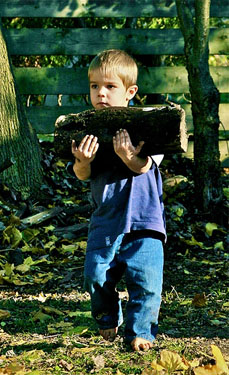 “ When the teachers were weary of my observations, they began to allow the children to do whatever they pleased. I saw children with their feet on the tables, or with their fingers in their noses, and no intervention was made to correct them. I saw others push their companions, and I saw dawn in the faces of these an expression of violence; and not the slightest attention on the part of the teacher. Then I had to intervene to show with what absolute rigor it is necessary to hinder, and little by little suppress, all those things which we must not do…
“ When the teachers were weary of my observations, they began to allow the children to do whatever they pleased. I saw children with their feet on the tables, or with their fingers in their noses, and no intervention was made to correct them. I saw others push their companions, and I saw dawn in the faces of these an expression of violence; and not the slightest attention on the part of the teacher. Then I had to intervene to show with what absolute rigor it is necessary to hinder, and little by little suppress, all those things which we must not do…  “It is a commonplace that the child must be free. But what kind
of freedom has he been given? The only true freedom for an
individual is to have the opportunity to act independently. That
is the condition sine qua non of individuality. There is no such
thing as an individual until a person can act by himself. The
instinct guiding the child to seek his independence thus leads us
to realize what the whole of nature demonstrates – that any sort
of association is composed of separate individuals. Otherwise
there would be no such thing as societies, but only colonies.
Education must foster both the development of individuality
and that of society. Society cannot develop unless the
individual develops, as we learn from observing the child, who
immediately uses his newly won independence to act on a social
environment.”
“It is a commonplace that the child must be free. But what kind
of freedom has he been given? The only true freedom for an
individual is to have the opportunity to act independently. That
is the condition sine qua non of individuality. There is no such
thing as an individual until a person can act by himself. The
instinct guiding the child to seek his independence thus leads us
to realize what the whole of nature demonstrates – that any sort
of association is composed of separate individuals. Otherwise
there would be no such thing as societies, but only colonies.
Education must foster both the development of individuality
and that of society. Society cannot develop unless the
individual develops, as we learn from observing the child, who
immediately uses his newly won independence to act on a social
environment.”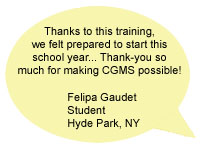 Our next
Our next 